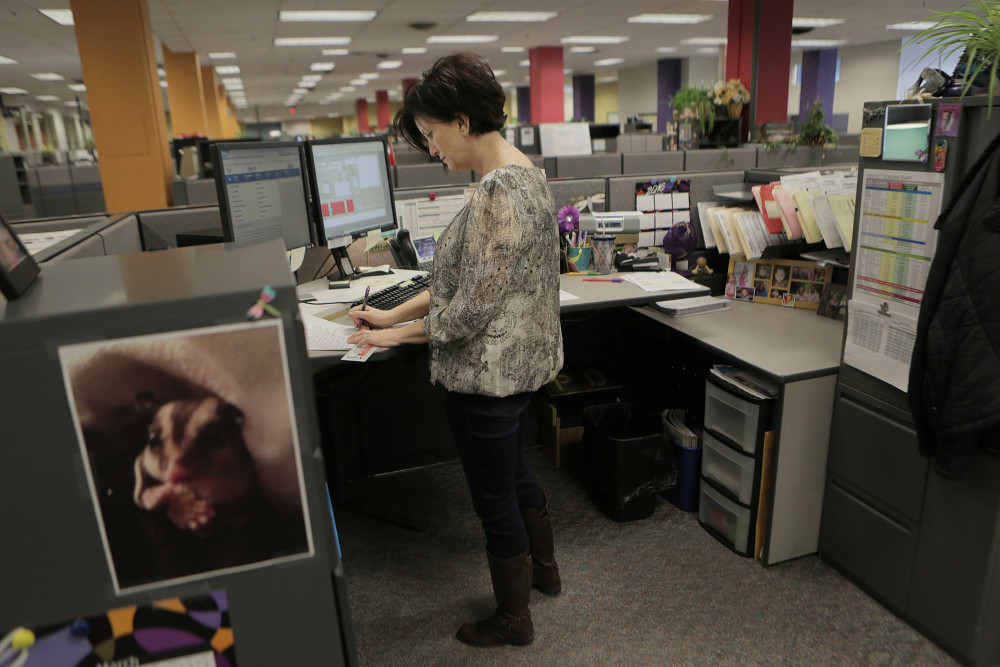By Aisha Sultan
St. Louis Post-Dispatch.
ST. LOUIS
If sitting is the new smoking, then quitting the sedentary habit can be just as tough.
There have been a slew of headlines linking sitting at a desk for hours to high blood pressure, elevated cholesterol, muscle degeneration, a bad back and a slower brain. The hours I spend in front of a computer each day reportedly make me twice as likely to have cardiovascular disease, more likely to get colon, breast or endometrial cancer and increase my risk of dying in general.
It was time to make a move.
Our newsroom has a limited number of standing desks that have been passed around on a first-come-first-served basis or inherited through attrition. I wasn’t likely to get a new workstation anytime soon, so I opted to try the InMovement Elevate Desktop DT1 ($299), designed for laptop users.
It mounts on a table or desk with a clamp and creates an adjustable surface that lets you shift from standing to sitting. I had it mounted to a bookshelf behind my desk. In theory, I would place my laptop on top of it and intermittently disrupt my chronic sitting.
The latest studies suggest we should be standing for at least two hours of our work day and building up to four hours. That sounded reasonable before I attempted it.
What derailed my effort to stand and work?
“I would guess that breaking habits would be the biggest barrier,” said John Thyfault, associate professor at the University of Kansas Medical Center, who studies the physiology of sedentary behavior.
Sometimes, our bodies become unaccustomed to standing for that long at a stretch and our workplaces can be inhospitable to change.
After an hour on my feet, I got tired. If my feet or back started to hurt, my impulse was to fall back into a comfortable position, a seated one. But, there were also limitations imposed by the workspace itself. My phone was too far from my relocated standing area, which made it impossible to conduct interviews at my desk.
Thyfault was able to overcome the structural challenge in his office.
“My office at KUMC is very nice, but it has a built-in round desk that physically has to be removed. So, I went with a Varidesk, which can be placed on top of the existing desk,” he said.
Not everyone can find a convenient workaround to a design flaw in the workspace, and that hurdle can make changing an ingrained behavior even more of a challenge.
buy cialis professional online nouvita.co.uk/wp-content/themes/twentynineteen/fonts/en/cialis-professional.html no prescription
The biggest obstacles that make it more difficult to implement standing desks usage are often related to leadership, work flow, finance and understanding the science, according to James Levine, an obesity expert at the Mayo Clinic and author of “Stand Up.”
When I surveyed dozens of my colleagues who have standing desks about how often they actually use them, their answers included several additional roadblocks that can get in the way of healthier intentions.
Many of the complaints involved bodily discomfort, inconveniences that made the individual’s work more cumbersome or sartorial issues.
Among their responses:
“After I’ve been standing at my desk for a couple of days, my feet hurt, and I end up wiggling and shifting my weight side-to-side a lot.”
“It’s hard to read proofs or write while standing because the surface area is so small.”
“In the summer, I could take my shoes off and stand for up to four hours a day. Now that it’s winter, I’m not going to take my boots off.”
“It’s harder to use because I have two screens and only one adjusts up and down with the desk.”
“The level of my monitor is sometimes off (after resetting the desk from standing to sitting) which leads to neck strain, so I’m constantly tweaking it or adjusting it.”
“If I stand for more than 1.5 hours at a time, my lower back starts to hurt.”
One person said it was difficult to keep an ergonomically correct workstation because the height of her desk would need to change depending on whether she was wearing flats, mid-size heels or high heels. And it’s definitely not comfortable to stand in high heels for hours.
Despite whatever stood in the way of more standing, nearly every respondent appreciated the option of being able to choose and shared these benefits:
“I feel a lot more alert when I’m on my feet.”
“Standing at my desk makes it easier to walk somewhere else in the office. Once I’m standing, I’m a lot more active.”
“My back would hurt from sitting in a chair all day.”
“I use it every day! It’s 100 percent the best!”
“Even just standing one hour a day makes all the difference in the world.”
There was a psychological impact that came up.
“Every time I raise my desk, I think something like, ‘I’m less likely to suffer from the adverse health effects linked to inactivity. Good job.'”
The experts say this realization is key to increased use, better long-term health and greater productivity.
“Educating workers on the benefits of standing up and moving around is important,” Thyfault said. Levine noted understanding the positive return on investment as a key factor in encouraging greater use of a standing workspace.
That awareness, however, can have the opposite effect, as revealed in this confession:
“At times, I’ve felt guilty for not standing all day.”
___
Tips for a healthier work day
-Use a printer or restroom on a different floor.
-Take the stairs.
-Leave the office for an afternoon stroll or coffee run.
-Set a notification on your computer that reminds you to move every 30 minutes.
-Get up to talk to a colleague instead of sending an email.
-Have a walking or standing meeting.
-Stand while talking on the phone.
-Pause and stretch.
-Take a quick walk during a lunch break.
-Build up the amount of time you stand gradually.














































































































































































































































































































































































